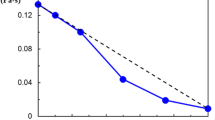Abstract
Soluplus® is a graft copolymer, with PEG and vinylcaprolactam/vinyl acetate side chains, recently available as excipient used to promote fast drug release in pharmaceutical dosage forms and as solubility enhancer. Despite this copolymer is reported to be able to act as a thickening additive and even as gelling agent as a function of temperature, there is a lack of information about the physical–chemical properties of its water dispersions. Thus, the aim of this paper is to investigate the influence of Soluplus® concentration and experimental temperature on the modification of the rheological properties of Soluplus® water dispersions. The results clearly indicated the influence of both the studied parameters and of their interactions on the Soluplus® thickening ability. Although some systems appear gel by human perception at 37 °C, the mechanical spectra demonstrated the lack of the formation of a tridimensional network structure. Overall, in all the analyzed temperatures and concentrations, the systems always behave as a “rheological” dilute or semidilute polymer solution.




Similar content being viewed by others
References
BASF (2010) Soluplus—technical information. The BASF Chemical Company-Pharma Ingredients & Services, Limburgerhof
Kolter K, Karl M, Gryczke A (2012) Hot-melt extrusion with BASF Pharma polymers extrusion compendium 2nd revised and enlarged edition
Nagy ZK, Balogh A, Vajna B, Farkas A, Patyi G, Kramarics A, Marosi G (2012) Comparison of electrospun and extruded soluplus®-based solid dosage forms of improved dissolution. J Pharm Sci 101(1):322–332
Caron V, Hu Y, Tajber L, Erxleben A, Corrigan OI, McArdle P, Healy AM (2013) Amorphous solid dispersions of Sulfonamide/Soluplus® and sulfonamide/PVP prepared by ball milling. AAPS PharmSciTech 14(1):464–474
Dierickx L, Saerens L, Almeida A, De Beer T, Remon JP, Vervaet C (2012) Co-extrusion as manufacturing technique for fixed-dose combination mini-matrices. Eur J Pharm Biopharm 81(3):683–689
Linn M, Collnot EM, Djuric D, Hempel K, Fabian E, Kolter K, Lehr CM (2012) Soluplus® as an effective absorption enhancer of poorly soluble drugs in vitro and in vivo. Eur J Pharm Sci 45(3):336–343
Terife G, Wang P, Faridi N, Gogos CG (2012) Hot melt mixing and foaming of soluplus® and indomethacin. Polym Eng Sci 52(8):1629–1639
Thakral NK, Ray AR, Bar-Shalom D, Eriksson AH, Majumdar DK (2012) Soluplus-solubilized citrated camptothecin—a potential drug delivery strategy in colon cancer. AAPS PharmSciTech 13(1):59–66
Taupitz T, Dressman JB, Buchanan CM, Klein S (2012) Cyclodextrin–water soluble polymer ternary complexes enhance the solubility and dissolution behaviour of poorly soluble drugs. Case example: Itraconazole. European Journal of Pharmaceutics and Biopharmaceutics
Hardung H, Djuric D, Ali S (2010) Combining HME & solubilization: Soluplus®—the solid solution. Drug Deliv Technol 10(3):20–27
Hughey JR, Keen JM, Miller DA, Kolter K, Langley N, McGinity JW (2013) The use of inorganic salts to improve the dissolution characteristics of tablets containing Soluplus®-based solid dispersions. Eur J Pharm Sci 48(4):758–766
Shamma RN, Basha M (2013) Soluplus®: A novel polymeric solubilizer for optimization of Carvedilol solid dispersions: Formulation design and effect of method of preparation. Powder Technology
BASF (2011) Solubility Enhancement with BASF Pharma Polymers-Solubilizer Compendium
Bonacucina G, Spina M, Misici-Falzi M, Cespi M, Pucciarelli S, Angeletti M, Palmieri GF (2007) Effect of hydroxypropyl β-cyclodextrin on the self-assembling and thermogelation properties of Poloxamer 407. Eur J Pharm Sci 32(2):115–122. doi:10.1016/j.ejps.2007.06.004
Bonacucina G, Cespi M, Mencarelli G, Giorgioni G, Palmieri GF (2011) Thermosensitive self-assembling block copolymers as drug delivery systems. Polymers 3(2):779–811
Bonacucina G, Cespi M, Misici-Falzi M, Palmieri GF (2009) Colloidal soft matter as drug delivery system. J Pharm Sci 98(1):1–42
Bonacucina G, Palmieri GF (2006) Acrylic polymers as thickening agents for tetraglycol cosolvent. J Pharm Sci 95(4):726–736
Clark A, Ross-Murphy S (1987) Structural and mechanical properties of biopolymer gels. In: Biopolymers, vol 83. Advances in polymer science. Springer: Berlin. pp 57–192. doi:10.1007/BFb0023332
Ikeda S, Nishinari K (2001) “Weak gel”-type rheological properties of aqueous dispersions of nonaggregated κ-carrageenan helices. J Agric Food Chem 49(9):4436–4441
Chenite A, Buschmann M, Wang D, Chaput C, Kandani N (2001) Rheological characterisation of thermogelling chitosan/glycerol-phosphate solutions. Carbohydr Polym 46(1):39–47
Ross-Murphy SB (1995) Rheological characterization of gels. J Texture Stud 26:391–400
Bonacucina G, Martelli S, Palmieri GF (2004) Rheological, mucoadhesive and release properties of carbopol gels in hydrophilic cosolvents. Int J Pharm 282(1–2):115–130
Bonacucina G, Cespi M, Misici-Falzi M, Palmieri GF (2006) Rheological, adhesive and release characterisation of semisolid carbopol/tetraglycol systems. Int J Pharm 307(2):129–140
Cespi M, Bonacucina G, Casettari L, Palmieri GF (2013) Rheological and thermo-mechanical properties of Sepifilm-Sepisperse water dispersions and films. Thermochim Acta 557:7–12
Kobayashi S, Tsujihata S, Hibi N, Tsukamoto Y (2002) Preparation and rheological characterization of carboxymethyl konjac glucomannan. Food Hydrocoll 16(4):289–294
Acknowledgments
The authors wish to thanks BASF (Lampertheim, Germany) for the generous donation of Soluplus®.
Author information
Authors and Affiliations
Corresponding author
Rights and permissions
About this article
Cite this article
Cespi, M., Casettari, L., Palmieri, G.F. et al. Rheological characterization of polyvinyl caprolactam–polyvinyl acetate–polyethylene glycol graft copolymer (Soluplus®) water dispersions. Colloid Polym Sci 292, 235–241 (2014). https://doi.org/10.1007/s00396-013-3077-8
Received:
Revised:
Accepted:
Published:
Issue Date:
DOI: https://doi.org/10.1007/s00396-013-3077-8




